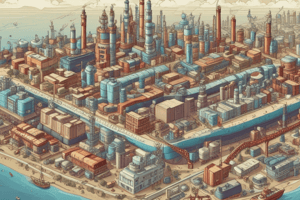Podcast
Questions and Answers
Which of the following is NOT considered a primary activity?
Which of the following is NOT considered a primary activity?
- Fishing
- Farming
- Forestry
- Manufacturing (correct)
What is the main purpose of primary activities?
What is the main purpose of primary activities?
- To produce goods for consumption or sale (correct)
- To facilitate transportation
- To provide services
- To manage finances
What characterizes secondary activities?
What characterizes secondary activities?
- They involve transforming primary goods into finished products. (correct)
- They primarily involve the extraction of minerals.
- They encompass industries such as commerce and finance.
- They are focused on providing services directly to consumers.
What is the primary purpose of hunting, fishing, and forestry?
What is the primary purpose of hunting, fishing, and forestry?
Which of the following is NOT a component of modern agriculture?
Which of the following is NOT a component of modern agriculture?
Which sector does finance fall under?
Which sector does finance fall under?
Which of the following is NOT a primary activity mentioned in the text?
Which of the following is NOT a primary activity mentioned in the text?
Which industry involves the extraction of minerals and non-renewable resources?
Which industry involves the extraction of minerals and non-renewable resources?
What distinguishes tertiary activities from secondary activities?
What distinguishes tertiary activities from secondary activities?
What is a key aspect of construction as a secondary activity?
What is a key aspect of construction as a secondary activity?
Study Notes
Activities: Primary, Secondary, Tertiary
Activities form an integral part of human lives across different age groups, occupations, and cultures. These activities can be categorized primarily based on their nature and purpose. The three main categories of activities are primary, secondary, and tertiary activities.
Primary Activities
Primary activities involve direct manipulation of raw materials to produce goods for consumption or sale. These activities are essential for maintaining life and are typically associated with rural societies where individuals engage in agriculture, hunting, fishing, and forestry.
Agriculture
Agriculture is the cultivation of plants and husbandry of livestock. It provides the foundation for food production, clothing, shelter, and various other aspects of life. Traditional farming practices involve tilling the soil, planting, and harvesting crops, while modern agriculture incorporates advanced technology, such as automated machinery, satellite imaging, and genetic engineering, to optimize crop yields and minimize resource use.
Hunting, Fishing, Forestry
Hunting, fishing, and forestry are primary activities that involve the exploitation of natural resources for sustenance and commerce. Hunting and fishing provide proteins and other essential nutrients, while forestry provides raw materials for building and manufacturing. These activities require a deep understanding of the natural environment, resource management, and conservation.
Secondary Activities
Secondary activities transform primary goods into finished products. These activities are typically associated with manufacturing and industrial economies. Secondary activities involve processing raw materials through a series of operations to create finished products.
Manufacturing
Manufacturing involves the production of goods through the use of machinery, tools, and technology. It encompasses a wide range of industries, from electronics and automotive to textiles and food processing. Manufacturing activities require a high degree of technical expertise, attention to detail, and adherence to safety and quality standards.
Construction and Mining
Construction and mining are secondary activities that involve the extraction and processing of raw materials for building and infrastructure development. Construction involves the design, planning, and execution of buildings, roads, bridges, and other structures, requiring a diverse set of skills in architecture, engineering, and project management. Mining, on the other hand, involves the extraction of minerals and non-renewable resources, requiring skills in geology, drilling, and heavy machinery operation.
Tertiary Activities
Tertiary activities involve providing services directly to consumers. These activities are often associated with advanced economies and urban centers. Tertiary activities can be further divided into three sectors: commerce, finance, and services.
Commerce and Finance
Commerce involves buying and selling goods and services between businesses, governments, nonprofit organizations, and consumers. It encompasses retail and wholesale trade, importing and exporting, marketing, and sales. Finance involves managing money, investments, and credit. Financial institutions, such as banks and insurance companies, play a crucial role in facilitating economic transactions and mitigating risk.
Services
The service sector provides intangible products and experiences that cater to the needs and desires of consumers. Examples of service-oriented jobs include healthcare professionals, educators, lawyers, architects, artists, and IT specialists. Service industries require a strong understanding of customer needs, communication skills, and technical competence depending on the specific job function.
In conclusion, activities form the backbone of human society, driving innovation, growth, and sustainability. Understanding the roles and dynamics of primary, secondary, and tertiary activities helps individuals appreciate the interconnectedness of modern economies and the diverse skill sets required to maintain a thriving society.
Studying That Suits You
Use AI to generate personalized quizzes and flashcards to suit your learning preferences.
Description
Test your knowledge on primary, secondary, and tertiary activities that form the backbone of human societies. Explore the differences between agriculture, manufacturing, commerce, and other key sectors that drive economies worldwide.




